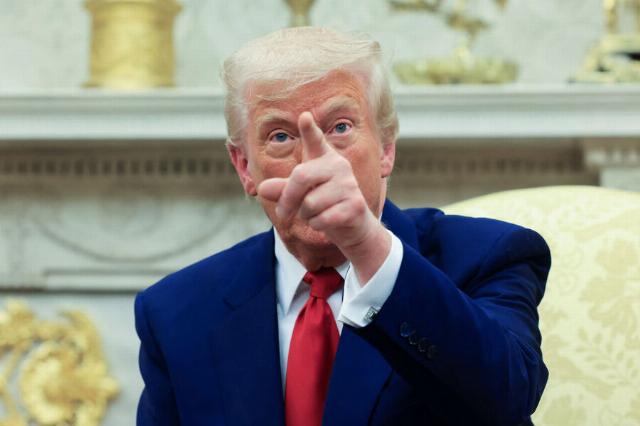Colonel Khodarenok: Trump increases the defense budget, taking into account HIS experience
US President Donald Trump announced that his administration has prepared a defense budget totaling approximately $1 trillion. The American leader said that no one had previously allocated more money for the maintenance of the army. Military observer of "Gazeta.En" Mikhail Khodarenok suggested what this money could be used for.
The first trillion
"We are saving a lot of money, but we need to build an army, and we need to be strong, because there are a lot of bad forces around now, so we will approve the budget, and I am proud to say this will be the largest budget we have provided to the military," Donald Trump said during a meeting with the Israeli Prime Minister. By Benjamin Netanyahu at the White House.
According to Bloomberg, the Donald Trump administration has not yet released a budget request for fiscal year 2026, as the government is acting under interim funding measures for this year. The draft budget is expected to be submitted no earlier than the end of spring this year.
Former U.S. Secretary of Defense Lloyd Austin has previously recommended that the U.S. government increase defense spending by about $50 billion more than previously projected in fiscal year 2026, bringing the Pentagon's budget to over $1 trillion in the coming years.
Curiously, the head of the Pentagon, Pete Hegseth, has recently been one of the most ardent supporters of Elon Musk's cost-cutting efforts aimed at improving government efficiency. With a total budget of $850 billion per year and approximately 2 million employees, the Pentagon is the largest government agency in the United States.
However, on April 8, Pete Hegseth wrote on the social network: "Coming soon: the first trillion-dollar budget for the U.S. Department of Defense. US President Donald Trump is rebuilding our armed forces - and fast."
At the same time, he stressed that the Pentagon intends to spend every taxpayer dollar wisely - "on striking capability and readiness."
In February, U.S. Secretary of State Marco Rubio ordered cuts in some unspecified categories of Pentagon and military spending by 8% and directed these funds to higher-priority programs such as missile defense. It is not yet clear how these cuts will be combined with the new budget.
Where will the money go?
US President Donald Trump intends to create the Iron Dome missile defense shield to protect the continental United States, and it has already received the unofficial name "Donald Trump's Great Missile Shield."
"I will instruct our military to begin construction of the great Iron Dome missile defense shield, which will be fully manufactured in the United States," the head of the White House announced earlier this year.
But even before the announcement of these strategic initiatives by Donald Trump, US efforts to modernize missile defense systems were significantly intensified. In 2025, $28.4 billion is expected to be allocated for missile defense in the United States, including $10.4 billion directly for the Missile Defense Agency (MDA), $9.5 billion for regional and strategic missile defense assets beyond the functions of the MDA, and $8.5 billion directly for measures to combat warheads. An ICBM.
For reference, the Russian military budget in 2024 amounted to $65.9 billion, that is, almost half of the Russian military budget in the United States goes only to work in the field of missile defense. And, quite possibly, after Trump's statements about the "great US missile shield," these allocations will be significantly increased.
Strategic deterrence remains the top priority of the U.S. Department of Defense. In the foreseeable future, nuclear weapons, according to the Pentagon, will continue to have a unique deterrent effect that no other element of military power can replace. The Pentagon intends to modernize its strategic nuclear forces, production and support infrastructure, scientific and engineering base. Naturally, all this requires a lot of money.
There is no doubt that the United States is carefully studying the experience of a Special military Operation and the most significant funds will be invested in improving unmanned systems of all types. Many experts consider UAVs using artificial intelligence to be perhaps the main tool in achieving their goals in the wars of the future.
Large funds will also be invested in the NGAD (Next Generation Air Dominance) program, which includes the deployment of an entire "family of connected systems" for conducting combat operations in airspace. They may include fighter jets, unmanned aerial vehicles, satellites in space, and platforms in cyberspace.
Whatever it was, the Donald Trump administration steadfastly adheres to the principle that "whoever has the most divisions is right and dictates the rules of geopolitical and geostrategic games." Moreover, divisions in this case should be understood as the combined military and economic potential, that is, the economic, financial and purely military capabilities of the United States. Hence the trillion dollar budget.
The opinion of the author may not coincide with the position of the editorial board.
Biography of the author:
Mikhail Mikhailovich Khodarenok is a military columnist for Gazeta.Ru", retired colonel.
He graduated from the Minsk Higher Engineering Anti-Aircraft Missile School (1976), the Military Air Defense Command Academy (1986).
Commander of the S-75 anti-aircraft missile division (1980-1983).
Deputy commander of the anti-aircraft missile regiment (1986-1988).
Senior Officer of the General Staff of the Air Defense Forces (1988-1992).
Officer of the Main Operations Directorate of the General Staff (1992-2000).
Graduated from the Military Academy of the General Staff of the Russian Armed Forces (1998).
Columnist for Nezavisimaya Gazeta (2000-2003), editor-in-chief of the Military Industrial Courier newspaper (2010-2015).
Mikhail Khodarenok

